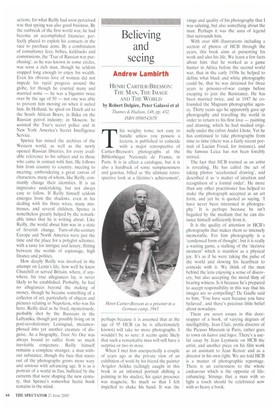Believing and seeing
Andrew Lambirth
HENRI CARTIER-BRESSON: THE MAN, THE IMAGE AND THE WORLD by Robert Delp ire, Peter Galassi et at Thames & Hudson, 1.48, pp. 432, ISBN 0500542678
his weighty tome, not easy to handle unless you possess a lectern, is published to coincide with a major retrospective of Cartier-Bresson's photographs at the Bibliotheque Nationale de France, in Paris. It is in effect a catalogue, but it is also a hardback of some sumptuousness and gravitas, billed as 'the ultimate retrospective look at a lifetime's achievement',
perhaps because it is assumed that at the age of 95 HCB (as he is affectionately known) will take no more photographs. I wouldn't be so sure: it seems quite likely that such a remarkable man will still have a surprise or two in store.
When I met him unexpectedly a couple of years ago at the private view of an exhibition of work by his friend the painter Avigdor Arikha (tellingly caught in this book in an informal portrait shifting a painting in his studio), his quiet presence was magnetic. So much so that I felt impelled to shake his hand. It was the range and quality of his photography that I was saluting, but also something about the man. Perhaps it was the aura of legend that surrounds him.
With over 600 illustrations including a section of photos of HCB through the years, this book aims at presenting his work and also his life. We learn a few facts about him: that he worked as a game hunter in Africa before the second world war, that in the early 1930s he helped to define what black and white photography could he, that he was detained for three years in prisoner-of-war camps before escaping to join the Resistance. He has been married twice, and in 1947 he cofounded the Magnum photographic agency. Thirty years ago he apparently gave up photography and travelling the world in order to return to his first love — painting and drawing, which he had studied originally under the cubist Andre Lhote. Yet he has continued to take photographs from time to time (there was a fairly recent portrait of Lucian Freud, for instance), and the famous Leica has not been forcibly retired.
The fact that HCB trained as an artist is revealing. He has called the act of taking photos 'accelerated drawing', and described it as 'a matter of intuition and recognition of a formal order'. He more than any other practitioner has helped to make the photograph accepted as an art form, and yet he is quoted as saying, 'I have never been interested in photography.' It is perhaps because he isn't beguiled by the medium that he can distance himself sufficiently from it.
It is the quality of attention in HCB's photographs that makes them so intensely memorable. For him photography is a 'condensed form of thought', but it is really a waiting game, a stalking of the 'decisive moment' which is manifest as a physical joy. It's as if he were taking the pulse of the world and slowing his heartbeat to coincide with it. We think of the man behind the lens enjoying a sense of discovery, but also accepting the moral luty of bearing witness. Is it because he's prepared to accept responsibility in this way that his images are so compelling? De Gaulle said to him, 'You have seen because you have believed', and there's precious little belief about nowadays.
There are seven essays in this doorstopper of a book, of varying degrees of intelligibility. Jean Clair, prolix director of the Picasso Museum in Paris, rather goes to town on kairos and logos. There's a useful essay by Jean Leymarie on HCB the artist, and another piece on his film work as an assistant to Jean Renoir and as a director in his own right. We are told HCB is a master of photographic reportage. There is an earnestness to the whole endeavour which is the opposite of lifeenhancing. Strange that a man with so light a touch should be celebrated now with so heavy a book.


































































































 Previous page
Previous page